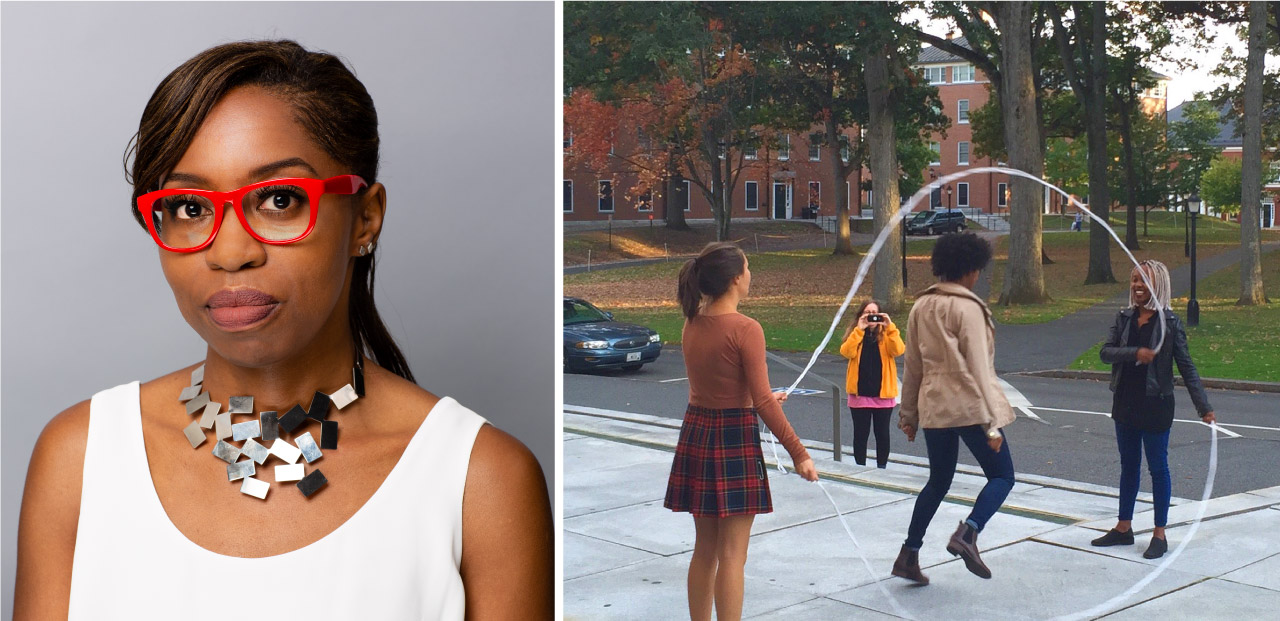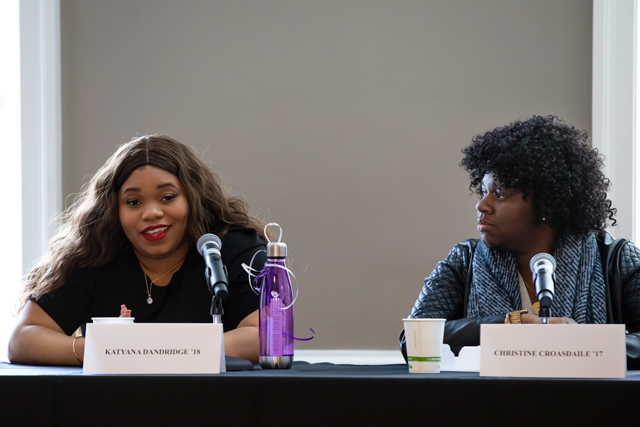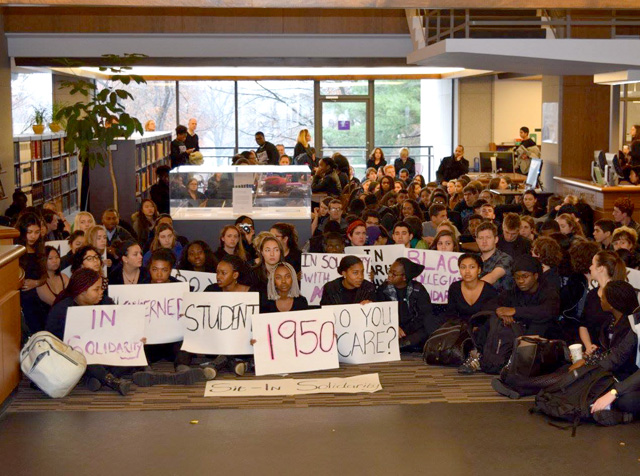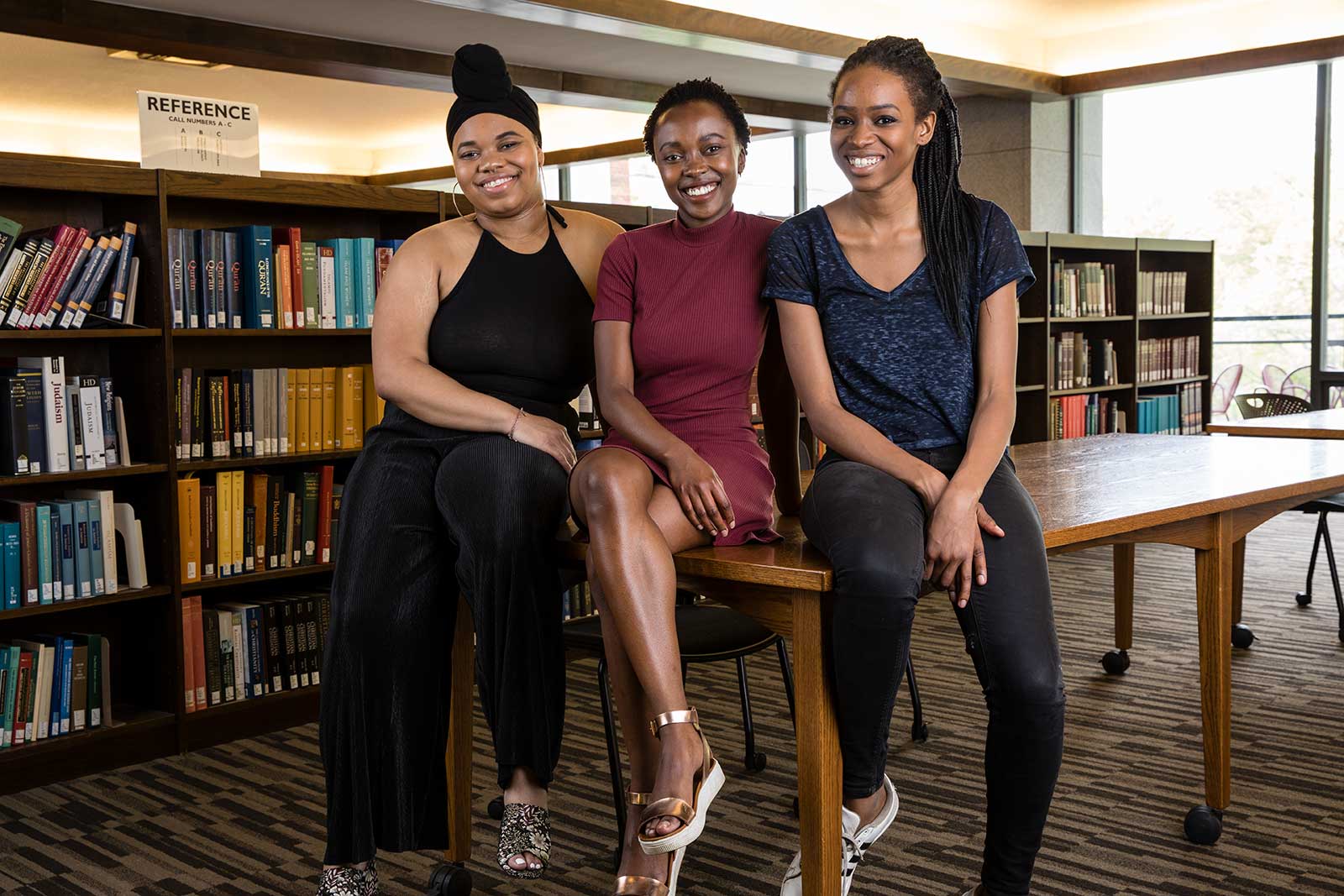Among the many inspirations for the Amherst Uprising, which took place five years ago this November and, says President Biddy Martin, “has changed virtually every domain at the College,” one must include Double Dutch.
This creative, complex kind of jumping rope is “very near and dear to a lot of Black women’s hearts,” said Katyana Dandridge ’18 in the online event “Alumni Reflections on the Fifth Anniversary of Amherst Uprising.” In fact, in the 2015 fall semester, Dandridge and Lerato Teffo ’18 were both taking the course “Bad Black Women,” in which Aneeka Henderson, assistant professor of sexuality, women’s and gender studies, focused on Black women and their methods of transgression—by deploying Double Dutch to make the theoretical real.
Assistant Professor Aneeka Henderson (left); photo by Maria Stenzel. Students Double Dutch outside Frost Library in 2015 (right); photo by Roberta Diehl.
“It was not just learning how to Double Dutch,” said Dandridge of that class assignment. “We had to learn how to do it in public and in different, unexpected places so that we would become spectacles and transgress a space.”
Dandridge, Teffo and Sanyu Takirambudde ’18 later took that idea of transgression and transfigured it into a show of support, at Frost Library, for students of color protesting the effects of marginalization at the University of Missouri, Yale and other institutions. They were also inspired by Black Lives Matter events put on by Amherst’s Black Student Union and Multicultural Resource Center. On the eve of their planned protest, the trio made signs, then bumped into a student from Hampshire College, who urged them to promote their protest on Facebook.
“And then the next day came,” said Dandridge. “We were all really nervous and shaking, but we thought it’ll probably be 20 people max at Frost. And then we showed and there were dozens and dozens of students. We were taken aback by the amount of support that people were showing, that they’d sit with us and show that Black students were not in this alone.”
Dandridge, now director of equity, programs and operations at ArtUp in Memphis, was one of five alumni who spoke at the anniversary event on Nov. 12. Amir Hall ’17, Christine Croasdaile ’17, Andrew Smith ’18 and moderator Lola Fadulu ’17 had all witnessed the Amherst Uprising.
Katyana Dandridge ’18 and Christine Croasdaile ’17 at Black Alumni Weekend in 2019. Photo by Jiayi Liu.
Isabella Edo ’21, a double major in Black studies and law, jurisprudence and social thought, also spoke about the Uprising’s lasting impact on current students. And Martin offered her recollections as well.
Fadulu, now a Washington Post reporter, reached out to Croasdaile, who is getting her J.D. and M.B.A. at Howard University: “Christine, I know that for a lot of students, the moment that you spoke up is what transformed this into the Amherst Uprising.” The others nodded in agreement.
Croasdaile recalled that moment: “Christin Washington, who’s also class of ’17, saw me shaking in my seat and she’s like, ‘What is going on, Christine?’ And I said, ‘I can’t let this moment pass. How can we say that we’re sitting in solidarity, but we’re not taking the mirror and looking back at ourselves?’ And she was like, ‘So get up and say it.’”
Our motto, Terras Irradient, is ‘Bring light to the world.’ The Amherst Uprising was truly a moment when we shed light on Amherst itself.”
— ChristinE Croasdaile ’17
On that first day of the Amherst Uprising, Croasdaile spoke of the inequities at the College for students of color—and that seemed to flip a switch for other students to speak of their pain and frustration.
Amir Hall, who is studying fiction writing at New York University, responded to Croasdaile: “It’s so important, those people that can recognize the fire and recognize the thing boiling over and give you that word of encouragement and confirmation. But for me, it was about supporting the people who were doing the work. Even then it was very common for Black women to lead activism work, group work.”
He continued: “The Amherst Uprising was one of the most sincere and organic moments of community that I’ve ever felt.”
The Amherst Uprising of 2015. Photo by Kaelan McCone ’19.
Smith, who is pursuing a master’s in human-computer interaction at the University of Maryland, is developing the website for the Amherst Uprising anniversary. During the online conversation, he displayed photos from the protest.
The alumni also shared thoughts on the Uprising’s influence on their current work and advocacy. Croasdaile, for instance, hopes to go into intellectual property law and help artists of color.
In the time of COVID, Edo conceded that large in-person gatherings like the Uprising will obviously not happen. But many exchanges about advocacy are taking place on social media among current students.
Katyana Dandridge ’18, Lerato Teffo ’18 and Sanyu Takirambudde ’18 in 2018. Photo by Takudzwa Tapfuma ’17.
Martin also reflected on the Uprising’s legacy on campus. “It would really be impossible to overstate the impact that the Amherst Uprising had, and it can be demonstrated in all sorts of ways,” she said. Her list was long: the opening of the Office of Diversity, Equity & Inclusion, hires in Asian American studies, the launching of a Latinx major, the recent hire of a specialist in Black political thought. Indeed, the hiring of faculty of color over the past five years has picked up “incredibly significantly, though it’s still nowhere close to what it needs to be for faculty to reflect the diversity of the student body,” said Martin.
She also mentioned academic programs that emerged out of the Uprising, such as Being Human in STEM and the science Incubator program. In athletics, she noted that four Black coaches were hired this past year (Rashad Devoe, Val Jones, Marlon Sears and Busani Xaba). “And the percentage of students of color now on varsity teams has risen significantly enough for people to reflect on it even in the New York Times. But again, not nearly enough.”
In the end, that coursework-inspired Double Dutch experience led to a leap in consciousness at Amherst. Or, as Croasdaile put it: “Our motto, Terras Irradient, is ‘Bring light to the world.’ The Amherst Uprising was truly a moment when we shed light on Amherst itself.”



